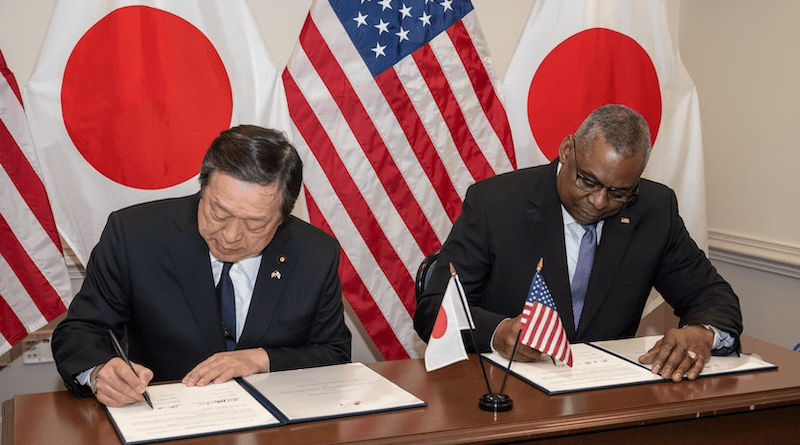US, Japan Defense Leaders Sign Documents To Strengthen Alliance Interoperability
By DoD News
By Jim Garamone
Secretary of Defense Lloyd J. Austin III and Japanese Defense Minister Yasukazu Hamada signed documents that will further strengthen the U.S.-Japanese Security Alliance Thursday at the Pentagon.
The two men met for bilateral talks in advance of President Joe Biden meeting Japanese Prime Minister Fumio Kishida at the White House tomorrow. That meeting caps what some in Washington are calling the month of “Japanuary” where leaders from both nations discussed Japan’s new national security strategy, national defense strategy and plans to double Japan’s defense spending by 2027.
Yesterday, Austin and Hamada joined Secretary of State Antony Blinken and Japanese Foreign Minister Yoshimasa Hayashi for the “2+2” talks.
“This year is an inflection point for our national security and defense strategies aligning closer than ever,” Austin said. “And with our shared goal of a new era of alliance modernization, I strongly support Japan’s updated national security policies including decisions to increase defense spending [to acquiring] counterstrike capabilities.”
Austin said he is also proud of the historic decision to update and modernize U.S. force posture in Japan “by forward stationing more versatile, mobile and resilient capabilities.” The United States will station a Marine Littoral Regiment in Japan by 2025.
The strategic situation is getting complicated, and Austin said the United States is concerned about China’s coercive behavior in the Taiwan Strait, and the waters surrounding Japan. North Korea’s continuing provocations and outright flaunting of U.N. Security Council Resolutions is also a concern. Russia’s “cruel, unprovoked and unjustifiable war of choice” against Ukraine has also changed the strategic calculus well beyond the theater of operations.
The U.S.-Japan Alliance “remains a cornerstone of peace and security in the Indo-Pacific and beyond,” Austin said. “I’m encouraged by the work we’re doing with our partners like Australia and the Republic of Korea. And I also want to reaffirm our unwavering commitment to the defense of Japan, including U.S. extended deterrence provided by the full range of conventional and nuclear capabilities.”
Austin and Hamada signed a bilateral Research, Development, Test and Evaluation Memorandum of Understanding and a bilateral, non-binding Security of Supply Arrangement.
The memo commits the two nations to work together on emerging technology to improve defense capabilities, Austin said. This will include such technologies as high-power microwaves, autonomous systems and counter-hypersonics.
The security of supply arrangement “will increase cooperation between our respective defense supply chains and build critical linkages between our defense industrial bases,” Austin said.

